FolkWorld article by
Sean Laffey:
From Cobh to Malabar
The Cobh Maritime Song Festival
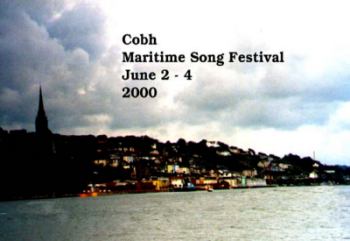 Like many towns in Ireland Cobh is coming to terms with its past and far from dwelling on the morbidity of emigration and naval skulduggery it is putting a cheerful face onto this new millennium. The waterfront is a jumble of riotously coloured three and four-storey Victorian properties, packed under cliffs above the bay where once liners and packet steamers would crowd the quaysides ready for the ultimate trip across the Western Ocean. The waterfront is being re-developed with a neo-Edwardian bandstand and blue painted canons facing south on the newly paved promenade. There's a Titanic centre on the way to completion too. The old Royal Cork Yacht Club, a mid19th century palladian box perching over the water, now houses the Sirius Arts centre (a great acoustic venue and named after the first trans-atlantic steamer that sailed from Cobh in 1838). A mere two hundred yards away is The Queenstown Story telling the tale of emigration. It is located in the railway station where many of those two and a half million émigrés alighted. Indeed it is still a rail halt, although these days it's a destination for curious day-trippers rather than those seeking foreign refuge from poverty, crop failures, the land system and a lack of opportunity.
Like many towns in Ireland Cobh is coming to terms with its past and far from dwelling on the morbidity of emigration and naval skulduggery it is putting a cheerful face onto this new millennium. The waterfront is a jumble of riotously coloured three and four-storey Victorian properties, packed under cliffs above the bay where once liners and packet steamers would crowd the quaysides ready for the ultimate trip across the Western Ocean. The waterfront is being re-developed with a neo-Edwardian bandstand and blue painted canons facing south on the newly paved promenade. There's a Titanic centre on the way to completion too. The old Royal Cork Yacht Club, a mid19th century palladian box perching over the water, now houses the Sirius Arts centre (a great acoustic venue and named after the first trans-atlantic steamer that sailed from Cobh in 1838). A mere two hundred yards away is The Queenstown Story telling the tale of emigration. It is located in the railway station where many of those two and a half million émigrés alighted. Indeed it is still a rail halt, although these days it's a destination for curious day-trippers rather than those seeking foreign refuge from poverty, crop failures, the land system and a lack of opportunity.
The location for a maritime festival couldn't be more appropriate. This is also the home of the Irish Marine Service who occupy nearby Haulbowlin. The Sirius centre is the former home to The Royal Cork Yacht club, the oldest in the world dating back to 1720 (although the club has now relocated to Crosshaven). A century later Cobh was a major centre for troop embarkation during the Napoleonic wars, and once peace arrived the town developed as a fashionable watering hole along the lines of Brighton. Walter Raleigh, the man credited with the introduction of the potato once lived across the bay. The Malabar connection? During the nineteenth century the British exploited the treak forests of the Indian province of Malabar for timber for ships decking, how many millions of Irish feet trod on those planks?
Cobh as the location for an Irish maritime festival couldn't be more appropriate.
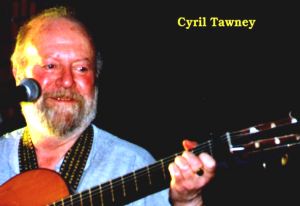 The maritime festival was the joint work of Ted Creedon and Jimmy Crowley, Ted from the Sirius Arts Centre and Jimmy in the guise of Free State Records, fired of course his long lasting love of maritime culture. The festival was a low-key affair; "It's better to get things right early on and build from a sound base than lose everything in one year" commented Ted when I met him at the Saturday night concert in the glass roofed Heritage Centre. The festival concentrated on three important concerts with after hour's sessions moving up the hill to the Braying Donkey pub, which is above the impressive Pugin Cathedral that dominates Cobh's skyline.
The maritime festival was the joint work of Ted Creedon and Jimmy Crowley, Ted from the Sirius Arts Centre and Jimmy in the guise of Free State Records, fired of course his long lasting love of maritime culture. The festival was a low-key affair; "It's better to get things right early on and build from a sound base than lose everything in one year" commented Ted when I met him at the Saturday night concert in the glass roofed Heritage Centre. The festival concentrated on three important concerts with after hour's sessions moving up the hill to the Braying Donkey pub, which is above the impressive Pugin Cathedral that dominates Cobh's skyline.
Guests for the concerts included Mick Maloney, Liam Clancy, Cyril Tawney and the Canniffe family. The Canniffe's began the Saturday evening with a number of songs more or less loosely connected to the sea They have a great grá for the songs of Delia Murphy and we were treated to If I were a Black Bird and the Queen of Connemara. Tim Canniffe had flown in from the South of France where he is on a short term posting in computing (how emigration has changed), he gave us a spirited version of The Lakes of Pontchartrain, with the comment "there's a sailor in one of the verses -somewhere!" (Check Sam Henry's Songs of the people to find the original Irish version - and discover how the lady in question has gone from blonde to brunette over the century - Ed.).
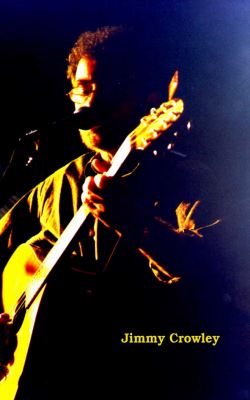 Jimmy Crowley acted as Fir a Ti for the night with tasters from his new album The Coast of Malabar thrown in to keep the music going. He sang The Girls of Ballytrapeen, originally collected by Cyril Tawney in the Royal Navy in the 1950's. It was a natural introduction to the veteran singer-songwriter, who was making her very first trip to Ireland. At over 70 he was in grand form. Playing a nylon-strung guitar his songs, many of which are recollections of life in the Royal Navy (where he was a sub-mariner) have become revival classics. He gave us The Oggy Man's No More, The Suit of Grey a poignant reminder that life is different outside of a sexy uniform, and his anthem of life in the under water service Diesel and Shale. He then went on to describe the time where he discovered his favourite folk song, The Dark Eyed Sailor.
Jimmy Crowley acted as Fir a Ti for the night with tasters from his new album The Coast of Malabar thrown in to keep the music going. He sang The Girls of Ballytrapeen, originally collected by Cyril Tawney in the Royal Navy in the 1950's. It was a natural introduction to the veteran singer-songwriter, who was making her very first trip to Ireland. At over 70 he was in grand form. Playing a nylon-strung guitar his songs, many of which are recollections of life in the Royal Navy (where he was a sub-mariner) have become revival classics. He gave us The Oggy Man's No More, The Suit of Grey a poignant reminder that life is different outside of a sexy uniform, and his anthem of life in the under water service Diesel and Shale. He then went on to describe the time where he discovered his favourite folk song, The Dark Eyed Sailor.
"I first heard this forty-one years ago in a Devonshire lane, sung by a bloody great extrovert Bert Edgecombe who came up to me in the Devon sunshine as a dark silhouette. Marching out with a stick in hand his hobnailed boots beating time as he sang this song. The great thing about this song", he continued "is that it has an air of truth about it, there's just something magical in the words and the music which tell you it was written from the heart and not by some broadside hack. It is so good, that it is found all over the English speaking world with hardly any variation at all. " (An almost identical version was collected by Miss Honoria Galway in Innishowen in 1846 and Christy Moore gave a fine rendition on his Prosperous album - side 1 track 2 on the original vinyl).
That song distilled the connections and the differences between the two cultures. The troops who assembled in Cobh in the 1800's were defending an Empire, where the military mind-set was deeply ingrained across all strands of society, (with a huge slice of bolshyness in the lower ranks). And so it continued giving rise to the sea shanties and songs of great confidence we associate with the British maritime tradition. Ireland's overwhelming experience of the sea in contrast was much more melancholy, although in historical fairness, about a third of all the seamen in the 19th century British naval services were Irish, and an equal proportion of sea songs have Irish tunes. But we never bought into the notion of an all encompassing empire and the bravado of the colonialist didn't sit easy with the Irish temperament.
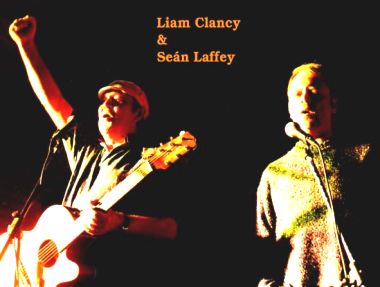 Liam Clancy arrived on stage with a rucksack and a battered guitar case. A pair of props that would culminate in a theatrical dénouement. He began with a poem on the importance of doing everything to the utmost. He continued with Ewan MacColl's The Wild and Wasteful Ocean, a song composed entirely of direct quotes from fisherman and the title from a line of Shakespeare (it's the name of his latest album - well a folksinger still has to make a living). Then the lifeboat anthem Home From the Sea a Phil Coulter song inspired by the tragic drowning of his own brother. Next a raucous sea shanty John Kanaka from the Pacific Whaling Fleet (at this stage Liam spotted me in the audience and cajoled me to join him on a chorus - we nearly burst our lungs - thanks big fella!). He toned the mood down with a concertina backed Loch Tay Boat song. The literally uplifting the Mary Ellen Carter (from the pen of the late Stan Rogers) brought our spirits high again and then the theatrical highlight of the night.
Liam Clancy arrived on stage with a rucksack and a battered guitar case. A pair of props that would culminate in a theatrical dénouement. He began with a poem on the importance of doing everything to the utmost. He continued with Ewan MacColl's The Wild and Wasteful Ocean, a song composed entirely of direct quotes from fisherman and the title from a line of Shakespeare (it's the name of his latest album - well a folksinger still has to make a living). Then the lifeboat anthem Home From the Sea a Phil Coulter song inspired by the tragic drowning of his own brother. Next a raucous sea shanty John Kanaka from the Pacific Whaling Fleet (at this stage Liam spotted me in the audience and cajoled me to join him on a chorus - we nearly burst our lungs - thanks big fella!). He toned the mood down with a concertina backed Loch Tay Boat song. The literally uplifting the Mary Ellen Carter (from the pen of the late Stan Rogers) brought our spirits high again and then the theatrical highlight of the night.
Liam read a passage from his autobiographical journal. He took us back to January 1956 and his departure from Cobh for a new life in America on board the SS Ivernia. In an echo of the introductory poem, he told us how daunting and exciting the adventure was, of the loss he faced, the American wake, the sense of excitement and freedom, in short all the mixed and jumbled baggage of youth on the move. The rucksack and the battered guitar case mirrored his first set of luggage and told us; no matter how far you move away there's always a trace of that eruption from the day of embarkation. He closed the show with Leave Her Johnny and The Dutchman. For an encore Jimmy, Liam and Cyril sang the Irish Rover- proving we have our own sense of bravado when the mood suits.
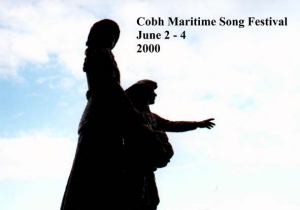 Afterwards a late night session of songs and serious chat about the folk process and the state of Irish culture continued into the small hours in the Braying Donkey. Meanwhile down on the quay outside the Cobh Heritage Centre is the statue of Annie Moore and her two brothers. Annie Moore became the first ever emigrant to be processed in Ellis Island when it officially opened on 1st January 1892. Annie and her brothers sailed from Queenstown on the SS Nevada on the 20th December and arrived after 12 days of travelling in steerage. The statue outside Cobh Heritage Centre was unveiled by President Mary Robinson on the 9th February 1993. A similar statue of Annie can be found in Ellis Island, New York which represents not only the honour of her being the first emigrant to pass through Ellis Island but also stands as a symbol of the many Irish who have embarked on that very same journey. A quick glance at the Cobh web site reveals a chilling statistic. 'Between 1848 - 1950 over 6 million adults and children emigrated from Ireland - over 2.5 million departed from Cobh, making it the single most important port of emigration.' If that isn't sombre enough, Cobh has links to the ill-fated maiden voyage of the Titanic and the 1915 sinking of the Lusitania. This is a town that has been so full of weeping beyond any normal human comprehension.
Afterwards a late night session of songs and serious chat about the folk process and the state of Irish culture continued into the small hours in the Braying Donkey. Meanwhile down on the quay outside the Cobh Heritage Centre is the statue of Annie Moore and her two brothers. Annie Moore became the first ever emigrant to be processed in Ellis Island when it officially opened on 1st January 1892. Annie and her brothers sailed from Queenstown on the SS Nevada on the 20th December and arrived after 12 days of travelling in steerage. The statue outside Cobh Heritage Centre was unveiled by President Mary Robinson on the 9th February 1993. A similar statue of Annie can be found in Ellis Island, New York which represents not only the honour of her being the first emigrant to pass through Ellis Island but also stands as a symbol of the many Irish who have embarked on that very same journey. A quick glance at the Cobh web site reveals a chilling statistic. 'Between 1848 - 1950 over 6 million adults and children emigrated from Ireland - over 2.5 million departed from Cobh, making it the single most important port of emigration.' If that isn't sombre enough, Cobh has links to the ill-fated maiden voyage of the Titanic and the 1915 sinking of the Lusitania. This is a town that has been so full of weeping beyond any normal human comprehension.
My overwhelming impression of the night was that the journey in the mind sails on the voices of singers. A song breaths life into the waterside effigies and statues of a terrible past; a song can tell us the most about of those who have gone before us.
Jimmy Crowley's "The Coast of Malabar" was released on Free State Records in mid June.
Photo Credit: Sean Laffey
Back to the content of FolkWorld Articles, Live Reviews & Columns
To the content of FolkWorld online magazine Nr. 15
© The Mollis - Editors of FolkWorld; Published 8/2000
All material published in FolkWorld is © The Author via FolkWorld. Storage for private use is allowed and welcome. Reviews and extracts of up to 200 words may be freely quoted and reproduced, if source and author are acknowledged. For any other reproduction please ask the Editors for permission.
FolkWorld - Home of European Folk Music

Layout & Idea of FolkWorld © The Mollis - Editors of FolkWorld
 Like many towns in Ireland Cobh is coming to terms with its past and far from dwelling on the morbidity of emigration and naval skulduggery it is putting a cheerful face onto this new millennium. The waterfront is a jumble of riotously coloured three and four-storey Victorian properties, packed under cliffs above the bay where once liners and packet steamers would crowd the quaysides ready for the ultimate trip across the Western Ocean. The waterfront is being re-developed with a neo-Edwardian bandstand and blue painted canons facing south on the newly paved promenade. There's a Titanic centre on the way to completion too. The old Royal Cork Yacht Club, a mid19th century palladian box perching over the water, now houses the Sirius Arts centre (a great acoustic venue and named after the first trans-atlantic steamer that sailed from Cobh in 1838). A mere two hundred yards away is The Queenstown Story telling the tale of emigration. It is located in the railway station where many of those two and a half million émigrés alighted. Indeed it is still a rail halt, although these days it's a destination for curious day-trippers rather than those seeking foreign refuge from poverty, crop failures, the land system and a lack of opportunity.
Like many towns in Ireland Cobh is coming to terms with its past and far from dwelling on the morbidity of emigration and naval skulduggery it is putting a cheerful face onto this new millennium. The waterfront is a jumble of riotously coloured three and four-storey Victorian properties, packed under cliffs above the bay where once liners and packet steamers would crowd the quaysides ready for the ultimate trip across the Western Ocean. The waterfront is being re-developed with a neo-Edwardian bandstand and blue painted canons facing south on the newly paved promenade. There's a Titanic centre on the way to completion too. The old Royal Cork Yacht Club, a mid19th century palladian box perching over the water, now houses the Sirius Arts centre (a great acoustic venue and named after the first trans-atlantic steamer that sailed from Cobh in 1838). A mere two hundred yards away is The Queenstown Story telling the tale of emigration. It is located in the railway station where many of those two and a half million émigrés alighted. Indeed it is still a rail halt, although these days it's a destination for curious day-trippers rather than those seeking foreign refuge from poverty, crop failures, the land system and a lack of opportunity.
 The maritime festival was the joint work of Ted Creedon and Jimmy Crowley, Ted from the Sirius Arts Centre and Jimmy in the guise of Free State Records, fired of course his long lasting love of maritime culture. The festival was a low-key affair; "It's better to get things right early on and build from a sound base than lose everything in one year" commented Ted when I met him at the Saturday night concert in the glass roofed Heritage Centre. The festival concentrated on three important concerts with after hour's sessions moving up the hill to the Braying Donkey pub, which is above the impressive Pugin Cathedral that dominates Cobh's skyline.
The maritime festival was the joint work of Ted Creedon and Jimmy Crowley, Ted from the Sirius Arts Centre and Jimmy in the guise of Free State Records, fired of course his long lasting love of maritime culture. The festival was a low-key affair; "It's better to get things right early on and build from a sound base than lose everything in one year" commented Ted when I met him at the Saturday night concert in the glass roofed Heritage Centre. The festival concentrated on three important concerts with after hour's sessions moving up the hill to the Braying Donkey pub, which is above the impressive Pugin Cathedral that dominates Cobh's skyline. Jimmy Crowley acted as Fir a Ti for the night with tasters from his new album The Coast of Malabar thrown in to keep the music going. He sang The Girls of Ballytrapeen, originally collected by Cyril Tawney in the Royal Navy in the 1950's. It was a natural introduction to the veteran singer-songwriter, who was making her very first trip to Ireland. At over 70 he was in grand form. Playing a nylon-strung guitar his songs, many of which are recollections of life in the Royal Navy (where he was a sub-mariner) have become revival classics. He gave us The Oggy Man's No More, The Suit of Grey a poignant reminder that life is different outside of a sexy uniform, and his anthem of life in the under water service Diesel and Shale. He then went on to describe the time where he discovered his favourite folk song, The Dark Eyed Sailor.
Jimmy Crowley acted as Fir a Ti for the night with tasters from his new album The Coast of Malabar thrown in to keep the music going. He sang The Girls of Ballytrapeen, originally collected by Cyril Tawney in the Royal Navy in the 1950's. It was a natural introduction to the veteran singer-songwriter, who was making her very first trip to Ireland. At over 70 he was in grand form. Playing a nylon-strung guitar his songs, many of which are recollections of life in the Royal Navy (where he was a sub-mariner) have become revival classics. He gave us The Oggy Man's No More, The Suit of Grey a poignant reminder that life is different outside of a sexy uniform, and his anthem of life in the under water service Diesel and Shale. He then went on to describe the time where he discovered his favourite folk song, The Dark Eyed Sailor. Liam Clancy arrived on stage with a rucksack and a battered guitar case. A pair of props that would culminate in a theatrical dénouement. He began with a poem on the importance of doing everything to the utmost. He continued with Ewan MacColl's The Wild and Wasteful Ocean, a song composed entirely of direct quotes from fisherman and the title from a line of Shakespeare (it's the name of his latest album - well a folksinger still has to make a living). Then the lifeboat anthem Home From the Sea a Phil Coulter song inspired by the tragic drowning of his own brother. Next a raucous sea shanty John Kanaka from the Pacific Whaling Fleet (at this stage Liam spotted me in the audience and cajoled me to join him on a chorus - we nearly burst our lungs - thanks big fella!). He toned the mood down with a concertina backed Loch Tay Boat song. The literally uplifting the Mary Ellen Carter (from the pen of the late Stan Rogers) brought our spirits high again and then the theatrical highlight of the night.
Liam Clancy arrived on stage with a rucksack and a battered guitar case. A pair of props that would culminate in a theatrical dénouement. He began with a poem on the importance of doing everything to the utmost. He continued with Ewan MacColl's The Wild and Wasteful Ocean, a song composed entirely of direct quotes from fisherman and the title from a line of Shakespeare (it's the name of his latest album - well a folksinger still has to make a living). Then the lifeboat anthem Home From the Sea a Phil Coulter song inspired by the tragic drowning of his own brother. Next a raucous sea shanty John Kanaka from the Pacific Whaling Fleet (at this stage Liam spotted me in the audience and cajoled me to join him on a chorus - we nearly burst our lungs - thanks big fella!). He toned the mood down with a concertina backed Loch Tay Boat song. The literally uplifting the Mary Ellen Carter (from the pen of the late Stan Rogers) brought our spirits high again and then the theatrical highlight of the night. Afterwards a late night session of songs and serious chat about the folk process and the state of Irish culture continued into the small hours in the Braying Donkey. Meanwhile down on the quay outside the Cobh Heritage Centre is the statue of Annie Moore and her two brothers. Annie Moore became the first ever emigrant to be processed in Ellis Island when it officially opened on 1st January 1892. Annie and her brothers sailed from Queenstown on the SS Nevada on the 20th December and arrived after 12 days of travelling in steerage. The statue outside Cobh Heritage Centre was unveiled by President Mary Robinson on the 9th February 1993. A similar statue of Annie can be found in Ellis Island, New York which represents not only the honour of her being the first emigrant to pass through Ellis Island but also stands as a symbol of the many Irish who have embarked on that very same journey. A quick glance at the Cobh web site reveals a chilling statistic. 'Between 1848 - 1950 over 6 million adults and children emigrated from Ireland - over 2.5 million departed from Cobh, making it the single most important port of emigration.' If that isn't sombre enough, Cobh has links to the ill-fated maiden voyage of the Titanic and the 1915 sinking of the Lusitania. This is a town that has been so full of weeping beyond any normal human comprehension.
Afterwards a late night session of songs and serious chat about the folk process and the state of Irish culture continued into the small hours in the Braying Donkey. Meanwhile down on the quay outside the Cobh Heritage Centre is the statue of Annie Moore and her two brothers. Annie Moore became the first ever emigrant to be processed in Ellis Island when it officially opened on 1st January 1892. Annie and her brothers sailed from Queenstown on the SS Nevada on the 20th December and arrived after 12 days of travelling in steerage. The statue outside Cobh Heritage Centre was unveiled by President Mary Robinson on the 9th February 1993. A similar statue of Annie can be found in Ellis Island, New York which represents not only the honour of her being the first emigrant to pass through Ellis Island but also stands as a symbol of the many Irish who have embarked on that very same journey. A quick glance at the Cobh web site reveals a chilling statistic. 'Between 1848 - 1950 over 6 million adults and children emigrated from Ireland - over 2.5 million departed from Cobh, making it the single most important port of emigration.' If that isn't sombre enough, Cobh has links to the ill-fated maiden voyage of the Titanic and the 1915 sinking of the Lusitania. This is a town that has been so full of weeping beyond any normal human comprehension.